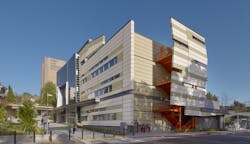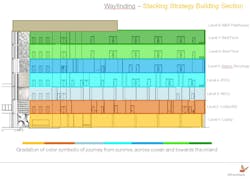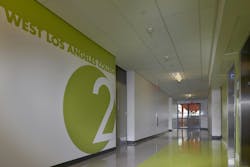Color’s prominent role in wayfinding has become a focus in architecture. Humans use color as a primary means of sorting and grouping objects: think about the uniforms of sports teams or the coloration of prescription medicine pills. Parking garages, for example, often code their floors by color, sometimes painting the uniquely colored floor number in a size three or four feet tall. Large, flat parking lots are often divided into sections that may be labeled by a number or a symbol—for example, zoos frequently use animals—but it is usually printed in a unique color. Color association is strong and memorable for regular occupants and occasional visitors alike.
In hospitals, color décor or signage are employed to help visitors locate their destinations. Sometimes they pair signs with colored lines painted on the corridor floors or walls, turning the floor itself into a giant map. A study conducted by Cromwell Architects Engineers and the University of Minnesota, published in 2012, found that color helped 72% of respondents to find remote locations in a pediatric clinic. Colored walls or floors were slightly more effective than color signage, and 58% correctly remembered a corridor color. When they were given verbal instructions that included the color, 69% remembered the correct color corridor.
For the upcoming Golisano Children’s Hospital in Fort Myers, Fla., advisory groups of children and parents were interviewed by the designers, FKP Architects, to discover aspects of their community that were meaningful to them: beaches, fishing, surfing, local animals. These became the inspirations for both color and texture selections that were used to define different areas. The floors of the building are color-coded, employing hues that had psychological impacts matching with the program of the space. Public lobbies and emergency room spaces on the first and second floors feature high-intensity colors, yellow and orange. The next three floors—housing chemo/oncology patients, the neonatal ICU, and the pediatric ICU—are decorated in calming shades of blue. At the top, bed floors feature medium-intensity greens drawn from nature.
Educational facilities are adopting similar strategies. West Los Angeles College is a community college, so it is frequently occupied by new students who may not know their way around. The new classroom building provides occupants with a strong visual link between color and floor number, a startling impression the moment a visitor steps out of the elevator. Wall and floor color cueing make it easy to orient oneself, even during the rush between classes.
Color is proving to be a powerful tool for designers, having an impact on both aesthetics and functionality. Carefully applied color not only provides wayfinding assistance, but can also be fully integrated into the aesthetic vision of the facility.


